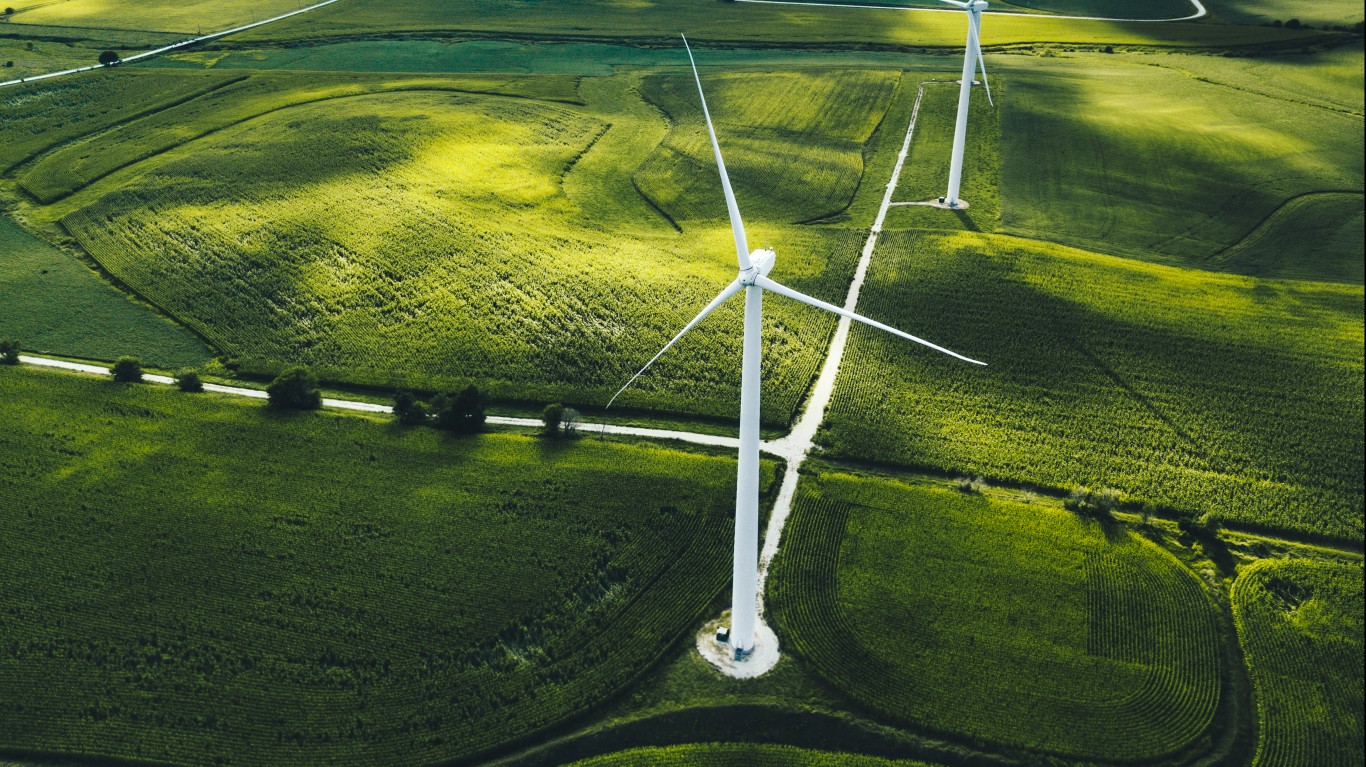Special Report
States Producing the Most Electricity From Renewable Sources

Published:

Amid ever-more dire warnings from many in the scientific community, the U.N. secretary general has recently listed the climate crisis among the top threats to global security. In an acknowledgement of the scope of the problem, President Joe Biden laid out a commitment to make the U.S power grid carbon-pollution free by 2035.
To realize this goal, the U.S. will need to turn away from fossil fuels and transition toward renewable energy sources – and doing so will require a major overhaul of the national energy sector. As of 2020, natural gas, petroleum, and coal — all pollution-generating, non-renewable sources — accounted for over 60% of U.S. electricity production. Here is a look at the cities emitting the most carbon dioxide in the world.
Still, some states are transitioning to renewable energy faster than others. Using data from the U.S. Energy Information Administration, 24/7 Wall St. identified the states producing the most electricity from renewable sources. States are ranked based on the share of electric power production from renewable sources, which are: biomass, geothermal, hydropower, solar, and wind.
Depending on the state, the share of electricity production coming from renewable sources ranges from 2.5% to nearly 100%. Encouragingly, the vast majority of states have increased their renewable electricity production in recent years. Over the past decade, renewable sources as a share of total energy production has increased by over 5 percentage points in most states.
It is important to note that while transitioning to renewable energy sources is critical to achieving a pollution-free energy sector, not all renewable energy sources are carbon neutral, just as not all non-renewable energy sources emit greenhouse gasses. Biomass, such as waste wood and crop residue is renewable, but when it is burned to produce electricity, it creates carbon. Similarly, though nuclear power plants are not classified as renewable sources, they do not produce air pollution. Here is a look at the states with the most nuclear power plants.
Click here to see the states producing the most electricity from renewable sources
Click here to read our detailed methodology

50. Delaware
> Electricity from renewables, 2020: 2.5% of total (131,394 MWh)
> 10-yr. change in share of renewable energy: +0.1 ppt. (the lowest)
> Largest renewable energy source: Other Biomass (72,042 MWh)
> Largest non-renewable energy source: Natural Gas (4.8 million MWh)
[in-text-ad]

49. Mississippi
> Electricity from renewables, 2020: 2.8% of total (1.8 million MWh)
> 10-yr. change in share of renewable energy: +0.1 ppt. (2nd lowest)
> Largest renewable energy source: Wood and Wood Derived Fuels (1.4 million MWh)
> Largest non-renewable energy source: Natural Gas (53.7 million MWh)

48. Ohio
> Electricity from renewables, 2020: 2.9% of total (3.5 million MWh)
> 10-yr. change in share of renewable energy: +2.1 ppt. (7th lowest)
> Largest renewable energy source: Wind (52.4 million MWh)
> Largest non-renewable energy source: Natural Gas (2.3 million MWh)

47. Connecticut
> Electricity from renewables, 2020: 3.2% of total (1.3 million MWh)
> 10-yr. change in share of renewable energy: -0.2 ppt. (2nd largest decline)
> Largest renewable energy source: Other Biomass (490,235 MWh)
> Largest non-renewable energy source: Natural Gas (23.5 million MWh)
[in-text-ad-2]

46. Louisiana
> Electricity from renewables, 2020: 3.3% of total (3.4 million MWh)
> 10-yr. change in share of renewable energy: -0.1 ppt. (3rd largest decline)
> Largest renewable energy source: Wood and Wood Derived Fuels (2.1 million MWh)
> Largest non-renewable energy source: Natural Gas (70.8 million MWh)

45. New Jersey
> Electricity from renewables, 2020: 3.4% of total (2.1 million MWh)
> 10-yr. change in share of renewable energy: +2.1 ppt. (6th lowest)
> Largest renewable energy source: Solar Thermal and Photovoltaic (1.3 million MWh)
> Largest non-renewable energy source: Natural Gas (30.6 million MWh)
[in-text-ad]

44. Pennsylvania
> Electricity from renewables, 2020: 3.7% of total (8.5 million MWh)
> 10-yr. change in share of renewable energy: +0.8 ppt. (3rd lowest)
> Largest renewable energy source: Wind (3.7 million MWh)
> Largest non-renewable energy source: Natural Gas (120.8 million MWh)

43. Florida
> Electricity from renewables, 2020: 4.3% of total (10.8 million MWh)
> 10-yr. change in share of renewable energy: +2.3 ppt. (8th lowest)
> Largest renewable energy source: Solar Thermal and Photovoltaic (6.5 million MWh)
> Largest non-renewable energy source: Natural Gas (189.4 million MWh)

42. West Virginia
> Electricity from renewables, 2020: 6.2% of total (3.5 million MWh)
> 10-yr. change in share of renewable energy: +3.3 ppt. (11th lowest)
> Largest renewable energy source: Wind (1.9 million MWh)
> Largest non-renewable energy source: Coal (50.2 million MWh)
[in-text-ad-2]

41. Virginia
> Electricity from renewables, 2020: 6.6% of total (6.8 million MWh)
> 10-yr. change in share of renewable energy: +1.5 ppt. (4th lowest)
> Largest renewable energy source: Wood and Wood Derived Fuels (2.4 million MWh)
> Largest non-renewable energy source: Natural Gas (62.6 million MWh)

40. Rhode Island
> Electricity from renewables, 2020: 6.9% of total (618096 MWh)
> 10-yr. change in share of renewable energy: +5.1 ppt. (17th lowest)
> Largest renewable energy source: Wind (214,735 MWh)
> Largest non-renewable energy source: Natural Gas (8.3 million MWh)
[in-text-ad]

39. Missouri
> Electricity from renewables, 2020: 7.5% of total (5.5 million MWh)
> 10-yr. change in share of renewable energy: +4.8 ppt. (16th lowest)
> Largest renewable energy source: Wind (3.3 million MWh)
> Largest non-renewable energy source: Coal (51.8 million MWh)

38. South Carolina
> Electricity from renewables, 2020: 7.8% of total (7.7 million MWh)
> 10-yr. change in share of renewable energy: +3.7 ppt. (14th lowest)
> Largest renewable energy source: Hydroelectric Conventional (3.9 million MWh)
> Largest non-renewable energy source: Nuclear (54.8 million MWh)

37. Indiana
> Electricity from renewables, 2020: 8.2% of total (7.4 million MWh)
> 10-yr. change in share of renewable energy: +5.2 ppt. (19th lowest)
> Largest renewable energy source: Wind (6.3 million MWh)
> Largest non-renewable energy source: Coal (47.8 million MWh)
[in-text-ad-2]

36. Kentucky
> Electricity from renewables, 2020: 8.5% of total (5.4 million MWh)
> 10-yr. change in share of renewable energy: +5.4 ppt. (20th lowest)
> Largest renewable energy source: Hydroelectric Conventional (5 million MWh)
> Largest non-renewable energy source: Coal (43.6 million MWh)

35. Maryland
> Electricity from renewables, 2020: 8.6% of total (3.1 million MWh)
> 10-yr. change in share of renewable energy: +3.5 ppt. (13th lowest)
> Largest renewable energy source: Hydroelectric Conventional (1.7 million MWh)
> Largest non-renewable energy source: Nuclear (15.1 million MWh)
[in-text-ad]

34. Massachusetts
> Electricity from renewables, 2020: 8.6% of total (3.5 million MWh)
> 10-yr. change in share of renewable energy: +13.9 ppt. (14th highest)
> Largest renewable energy source: Hydroelectric Conventional (3.2 million MWh)
> Largest non-renewable energy source: Natural Gas (1.9 million MWh)

33. Wisconsin
> Electricity from renewables, 2020: 9.4% of total (5.8 million MWh)
> 10-yr. change in share of renewable energy: +2.3 ppt. (9th lowest)
> Largest renewable energy source: Hydroelectric Conventional (2.8 million MWh)
> Largest non-renewable energy source: Coal (23.8 million MWh)

32. Illinois
> Electricity from renewables, 2020: 9.7% of total (16.8 million MWh)
> 10-yr. change in share of renewable energy: +7.1 ppt. (23rd highest)
> Largest renewable energy source: Wind (16.2 million MWh)
> Largest non-renewable energy source: Nuclear (100.2 million MWh)
[in-text-ad-2]

31. Michigan
> Electricity from renewables, 2020: 10.0% of total (10.7 million MWh)
> 10-yr. change in share of renewable energy: +6.4 ppt. (23rd lowest)
> Largest renewable energy source: Wind (6.7 million MWh)
> Largest non-renewable energy source: Natural Gas (36.4 million MWh)

30. Arkansas
> Electricity from renewables, 2020: 10.5% of total (5.7 million MWh)
> 10-yr. change in share of renewable energy: +1.8 ppt. (5th lowest)
> Largest renewable energy source: Hydroelectric Conventional (4.5 million MWh)
> Largest non-renewable energy source: Natural Gas (18.3 million MWh)
[in-text-ad]

29. Georgia
> Electricity from renewables, 2020: 11.9% of total (14.3 million MWh)
> 10-yr. change in share of renewable energy: +7.2 ppt. (22nd highest)
> Largest renewable energy source: Wood and Wood Derived Fuels (5.5 million MWh)
> Largest non-renewable energy source: Natural Gas (59.2 million MWh)

28. Arizona
> Electricity from renewables, 2020: 12.0% of total (13.1 million MWh)
> 10-yr. change in share of renewable energy: +5.8 ppt. (21st lowest)
> Largest renewable energy source: Hydroelectric Conventional (6.4 million MWh)
> Largest non-renewable energy source: Natural Gas (50.8 million MWh)

27. Alabama
> Electricity from renewables, 2020: 12.4% of total (17 million MWh)
> 10-yr. change in share of renewable energy: +5.1 ppt. (18th lowest)
> Largest renewable energy source: Hydroelectric Conventional (13.3 million MWh)
> Largest non-renewable energy source: Natural Gas (55.2 million MWh)
[in-text-ad-2]

26. Utah
> Electricity from renewables, 2020: 12.5% of total (4.6 million MWh)
> 10-yr. change in share of renewable energy: +9.0 ppt. (19th highest)
> Largest renewable energy source: Solar Thermal and Photovoltaic (2.6 million MWh)
> Largest non-renewable energy source: Coal (22.8 million MWh)

25. North Carolina
> Electricity from renewables, 2020: 15.5% of total (19.2 million MWh)
> 10-yr. change in share of renewable energy: +10.2 ppt. (17th highest)
> Largest renewable energy source: Solar Thermal and Photovoltaic (42.3 million MWh)
> Largest non-renewable energy source: Nuclear (8.3 million MWh)
[in-text-ad]

24. Hawaii
> Electricity from renewables, 2020: 15.9% of total (1.4 million MWh)
> 10-yr. change in share of renewable energy: +8.3 ppt. (20th highest)
> Largest renewable energy source: Wind (592,238 MWh)
> Largest non-renewable energy source: Petroleum (6.1 million MWh)

23. New Hampshire
> Electricity from renewables, 2020: 16.0% of total (2.6 million MWh)
> 10-yr. change in share of renewable energy: +3.8 ppt. (15th lowest)
> Largest renewable energy source: Hydroelectric Conventional (1.2 million MWh)
> Largest non-renewable energy source: Nuclear (9.9 million MWh)

22. Wyoming
> Electricity from renewables, 2020: 16.1% of total (6.8 million MWh)
> 10-yr. change in share of renewable energy: +7.2 ppt. (21st highest)
> Largest renewable energy source: Wind (5.5 million MWh)
> Largest non-renewable energy source: Coal (33.4 million MWh)
[in-text-ad-2]

21. Tennessee
> Electricity from renewables, 2020: 18.1% of total (14.6 million MWh)
> 10-yr. change in share of renewable energy: +7.0 ppt. (24th highest)
> Largest renewable energy source: Hydroelectric Conventional (13.5 million MWh)
> Largest non-renewable energy source: Nuclear (36.7 million MWh)

20. Texas
> Electricity from renewables, 2020: 21.8% of total (103.4 million MWh)
> 10-yr. change in share of renewable energy: +14.8 ppt. (12th highest)
> Largest renewable energy source: Wind (92.4 million MWh)
> Largest non-renewable energy source: Natural Gas (246.6 million MWh)
[in-text-ad]

19. New Mexico
> Electricity from renewables, 2020: 27.2% of total (9.3 million MWh)
> 10-yr. change in share of renewable energy: +21.4 ppt. (8th highest)
> Largest renewable energy source: Wind (7.2 million MWh)
> Largest non-renewable energy source: Coal (12.8 million MWh)

18. Minnesota
> Electricity from renewables, 2020: 27.6% of total (15.6 million MWh)
> 10-yr. change in share of renewable energy: +13.7 ppt. (16th highest)
> Largest renewable energy source: Wind (11.8 million MWh)
> Largest non-renewable energy source: Nuclear (14.7 million MWh)

17. New York
> Electricity from renewables, 2020: 28.5% of total (36.9 million MWh)
> 10-yr. change in share of renewable energy: +6.4 ppt. (22nd lowest)
> Largest renewable energy source: Hydroelectric Conventional (29.5 million MWh)
> Largest non-renewable energy source: Natural Gas (53 million MWh)
[in-text-ad-2]

16. Nevada
> Electricity from renewables, 2020: 28.8% of total (11.6 million MWh)
> 10-yr. change in share of renewable energy: +16.1 ppt. (11th highest)
> Largest renewable energy source: Solar Thermal and Photovoltaic (5.5 million MWh)
> Largest non-renewable energy source: Natural Gas (26.8 million MWh)

15. Nebraska
> Electricity from renewables, 2020: 28.9% of total (10.6 million MWh)
> 10-yr. change in share of renewable energy: +24.0 ppt. (7th highest)
> Largest renewable energy source: Wind (9.1 million MWh)
> Largest non-renewable energy source: Coal (18.8 million MWh)
[in-text-ad]

14. Alaska
> Electricity from renewables, 2020: 30.8% of total (1.9 million MWh)
> 10-yr. change in share of renewable energy: +9.3 ppt. (18th highest)
> Largest renewable energy source: Hydroelectric Conventional (1.8 million MWh)
> Largest non-renewable energy source: Natural Gas (2.6 million MWh)

13. Colorado
> Electricity from renewables, 2020: 30.9% of total (16.7 million MWh)
> 10-yr. change in share of renewable energy: +20.8 ppt. (9th highest)
> Largest renewable energy source: Wind (13.4 million MWh)
> Largest non-renewable energy source: Coal (19.5 million MWh)

12. North Dakota
> Electricity from renewables, 2020: 38.1% of total (16.1 million MWh)
> 10-yr. change in share of renewable energy: +20.4 ppt. (10th highest)
> Largest renewable energy source: Wind (13.6 million MWh)
> Largest non-renewable energy source: Coal (24.5 million MWh)
[in-text-ad-2]

11. Oklahoma
> Electricity from renewables, 2020: 39.7% of total (32.7 million MWh)
> 10-yr. change in share of renewable energy: +30.1 ppt. (4th highest)
> Largest renewable energy source: Wind (29.4 million MWh)
> Largest non-renewable energy source: Natural Gas (43.8 million MWh)

10. California
> Electricity from renewables, 2020: 42.6% of total (82.2 million MWh)
> 10-yr. change in share of renewable energy: +13.7 ppt. (15th highest)
> Largest renewable energy source: Solar Thermal and Photovoltaic (30.3 million MWh)
> Largest non-renewable energy source: Natural Gas (92 million MWh)
[in-text-ad]

9. Kansas
> Electricity from renewables, 2020: 44.2% of total (24.1 million MWh)
> 10-yr. change in share of renewable energy: +37.0 ppt. (3rd highest)
> Largest renewable energy source: Wind (24 million MWh)
> Largest non-renewable energy source: Coal (17 million MWh)

8. Montana
> Electricity from renewables, 2020: 59.4% of total (13.9 million MWh)
> 10-yr. change in share of renewable energy: +24.4 ppt. (6th highest)
> Largest renewable energy source: Hydroelectric Conventional (10.7 million MWh)
> Largest non-renewable energy source: Coal (8.5 million MWh)

7. Iowa
> Electricity from renewables, 2020: 59.4% of total (35.4 million MWh)
> 10-yr. change in share of renewable energy: +41.5 ppt. (2nd highest)
> Largest renewable energy source: Wind (34.2 million MWh)
> Largest non-renewable energy source: Coal (14.1 million MWh)
[in-text-ad-2]

6. Oregon
> Electricity from renewables, 2020: 67.5% of total (42.9 million MWh)
> 10-yr. change in share of renewable energy: +3.4 ppt. (12th lowest)
> Largest renewable energy source: Hydroelectric Conventional (31.9 million MWh)
> Largest non-renewable energy source: Natural Gas (19 million MWh)

5. Washington
> Electricity from renewables, 2020: 75.0% of total (87.1 million MWh)
> 10-yr. change in share of renewable energy: +2.6 ppt. (10th lowest)
> Largest renewable energy source: Hydroelectric Conventional (76.4 million MWh)
> Largest non-renewable energy source: Natural Gas (14 million MWh)
[in-text-ad]

4. Idaho
> Electricity from renewables, 2020: 76.1% of total (13.5 million MWh)
> 10-yr. change in share of renewable energy: -8.5 ppt. (the largest decline)
> Largest renewable energy source: Hydroelectric Conventional (9.5 million MWh)
> Largest non-renewable energy source: Natural Gas (4.2 million MWh)

3. Maine
> Electricity from renewables, 2020: 76.7% of total (7.7 million MWh)
> 10-yr. change in share of renewable energy: +29.9 ppt. (5th highest)
> Largest renewable energy source: Solar Thermal and Photovoltaic (1.4 million MWh)
> Largest non-renewable energy source: Natural Gas (14.2 million MWh)

2. South Dakota
> Electricity from renewables, 2020: 80.5% of total (11.4 million MWh)
> 10-yr. change in share of renewable energy: +14.7 ppt. (13th highest)
> Largest renewable energy source: Hydroelectric Conventional (5.8 million MWh)
> Largest non-renewable energy source: Coal (1.6 million MWh)
[in-text-ad-2]

1. Vermont
> Electricity from renewables, 2020: 99.9% of total (2.2 million MWh)
> 10-yr. change in share of renewable energy: +72.3 ppt. (the highest)
> Largest renewable energy source: Hydroelectric Conventional (1.1 million MWh)
> Largest non-renewable energy source: Natural Gas (2021.0 MWh)
Methodology
To identify the amount of renewable energy your state produces, 24/7 Wall St. reviewed the percentage of electricity produced by each state that comes from renewable sources in 2020 from the Energy Information Administration. Sources of renewable energy include conventional hydroelectric, geothermal, wind, solar, wood and wood derived fuels, and other biomass. Each state’s largest source of renewable and non-renewable energy also came from the EIA report.
Credit card companies are at war. The biggest issuers are handing out free rewards and benefits to win the best customers.
It’s possible to find cards paying unlimited 1.5%, 2%, and even more today. That’s free money for qualified borrowers, and the type of thing that would be crazy to pass up. Those rewards can add up to thousands of dollars every year in free money, and include other benefits as well.
We’ve assembled some of the best credit cards for users today. Don’t miss these offers because they won’t be this good forever.
Flywheel Publishing has partnered with CardRatings for our coverage of credit card products. Flywheel Publishing and CardRatings may receive a commission from card issuers.
Thank you for reading! Have some feedback for us?
Contact the 24/7 Wall St. editorial team.